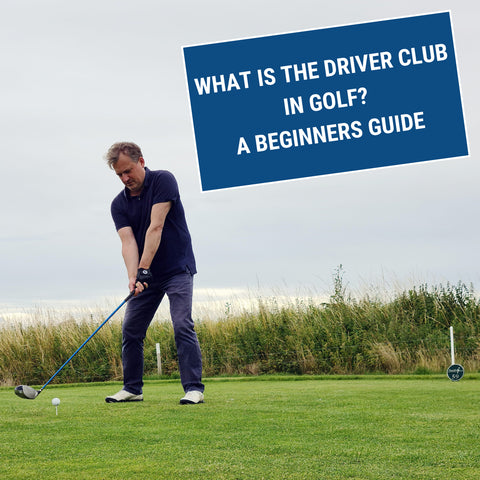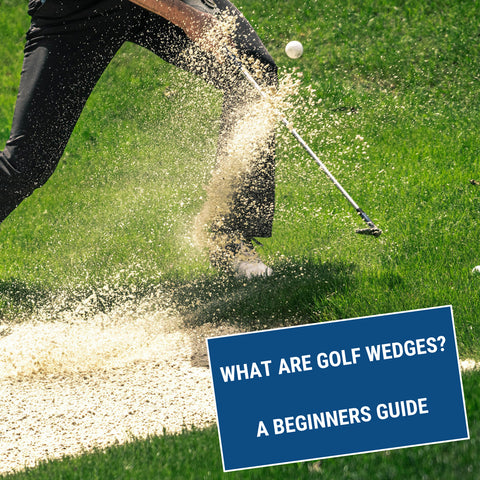Table of Contents
- Introduction
- The Basics of Driver Clubs
- Key Components of a Driver Club
- Understanding Shaft Flex Variations
- Maximizing Driver Performance
- Types of Driver Clubs
- Personalization and Improvement
- Summary
- FAQ
Explore our wider series on the different types of golf clubs
When it comes to the dynamic game of golf, few moments are as exhilarating as the crisp sound of a driver striking a ball perched on a tee. The driver, a club with unparalleled power and precision, holds a special place in every golfer's heart. As beginners step onto the teeing ground, the prospect of wielding this mighty club can be both thrilling and daunting. This guide delves into the world of driver clubs, illuminating their significance and unravelling their mysteries for those just embarking on their golfing journey.
The Basics of Driver Clubs
| Aspect | Description |
|---|---|
| Clubhead Size | The largest clubhead among golf clubs, providing a larger sweet spot and potential for increased forgiveness. |
| Loft | Low loft angle, usually between 8-12 degrees, to launch the ball with minimal backspin for distance. |
| Shaft Length | Longer shaft compared to other clubs, contributing to greater clubhead speed and distance potential. |
| Shaft Flex | Varies from extra stiff to ladies, influencing ball flight based on swing speed and player characteristics. |
| Face Angle | The direction the clubface points at address, affecting shot direction and trajectory. |
| Clubhead Weight | Typically lighter clubhead to enhance clubhead speed, but weight distribution can vary for different shot shapes. |
At the heart of a golfer's arsenal lies the driver, an instrument of potential greatness. A driver club, often referred to simply as a "driver," is the club designed for the longest shots in a golfer's repertoire. Its distinctive nature is woven into the "woods" category of golf clubs, with the driver reigning as the largest and most formidable member of this family. Think of it as the heavyweight champion of clubs, poised to deliver staggering distances and breath-taking drives.
When golfers speak of the "1-Wood," they're invoking the name of the driver itself. This designation highlights its prestige as the primary choice for launching the ball from the teeing ground. Picture a par-4, par-5, or even a challenging par-3 hole—on these occasions, the driver steps into the limelight, ready to propel the ball towards distant horizons.
Key Components of a Driver Club
As we delve deeper into the intricacies of driver clubs, it becomes evident that every element plays a pivotal role in shaping the outcome of a shot. One of these essential elements is the driver's face angle. The face angle refers to the position of the clubface in relation to the target line. A slight variance in this angle can wield a significant influence on the ball's trajectory. Whether it's an open face, promoting a fade, or a closed face, encouraging a draw, understanding and manipulating the face angle allows golfers to sculpt their shots with finesse.
Loft, another critical aspect, dictates the launch angle of the ball off the clubface. Drivers boast varying loft angles, each influencing ball flight in unique ways. A higher loft can aid novice golfers in achieving higher trajectories, while a lower loft might suit experienced players seeking greater distance through a flatter trajectory.
Tee height might seem like a minor consideration, but it's a factor that holds substantial sway over a driver's performance. Finding the optimal tee height involves striking a balance between a sweeping upward strike and maintaining control. Experimentation with tee height can yield considerable improvements in shot consistency and distance.
Driver head size emerges as a regulatory influence. With head size restrictions capped at around 460cc, golf's governing bodies ensure that technological advancements do not override the skill and finesse inherent in the game. This limitation underscores the delicate equilibrium between innovation and preserving the sport's essence.
Understanding Shaft Flex Variations
Shaft flexibility introduces a dynamic dimension to the driver club. With options ranging from extra stiff to ladies flex, choosing the right shaft flex is akin to fitting a puzzle piece that complements a golfer's swing characteristics. Swing speed serves as the main factor in this decision-making process. A player with a high swing speed might gravitate towards an extra stiff shaft to harness the energy effectively, while a golfer with a moderate swing speed could find their rhythm with a regular or stiff shaft.
Different Types of Golf Shaft Flexes
| Shaft Type | Flex Level | Characteristics | Suitable for |
|---|---|---|---|
| Extra Stiff | Very rigid | Provides minimal bending during swing | Golfers with very high swing speeds |
| Stiff | Firm | Offers less bending than regular shafts | Golfers with above-average swing speeds |
| Regular | Moderate | Balances flexibility and control | Most average swing speed golfers |
| Senior | Flexible | Offers more bend for slower swing speeds | Golfers with slower swing speeds and older players |
| Ladies | Very flexible | Provides maximum bending for slow swing speeds | Female golfers with slower swing speeds |
Moreover, a player's individual characteristics, such as strength and playing style, further influence the ideal shaft flex. The interaction between shaft flex and swing mechanics can determine not only shot accuracy but also the coveted distance coveted by golfers of all skill levels.
Maximizing Driver Performance
Hitting a driver with finesse is both an art and a science. To unlock its true potential, here are some golf tips that can help you master this mighty club:
-
Stance and Alignment: Start with a shoulder-width stance and ensure your feet are aligned parallel to the target line. This sets a solid foundation for a balanced and controlled swing.
-
Tee Placement: Experiment with tee height to find the sweet spot that suits your swing. Generally, half the ball above the driver's crown is a good starting point.
-
Smooth Transition: Avoid rushing your backswing. A smooth and controlled transition between backswing and downswing can lead to better timing and accuracy.
-
Swing Plane: Maintain a shallow angle of attack to promote a sweeping strike. This reduces the chances of hitting the ball too high on the clubface.
-
Follow Through: Allow your body to rotate fully during the follow-through, ensuring a complete and powerful swing motion.
When it comes to distance, technique is paramount. Focus on the following aspects to add yards to your drives:
-
Leverage the Body: Engage your core and hips to generate rotational power. A coordinated movement of the lower body contributes significantly to clubhead speed.
-
Utilize the Lag: Lag is the delay between your hands and the clubhead reaching the ball. Maintaining this lag before impact can translate to increased clubhead speed.
-
Centre of Gravity and Weight: Driver designs incorporate adjustable weights that influence the centre of gravity. Experiment with weight placements to fine-tune ball flight and enhance your shot shape.
Types of Driver Clubs
Driver clubs come in diverse options, each designed to shape shots according to distinct preferences. Here are some common types based on their face bias:
-
Closed Face Driver: This driver has a clubface angled slightly towards the golfer at address. It can help correct slices by promoting a draw—a controlled right-to-left shot.
-
Draw Driver: Designed with an inherent draw bias, this club assists in generating shots that curve gently from right to left for right-handed players, and vice versa for lefties.
-
Draw Bias Driver: Amplifying the draw effect, this driver is engineered to make shaping shots easier for players who struggle with fades.
-
Neutral Face Driver: Positioned for a straight-ahead shot, the neutral face driver is ideal for golfers seeking a balanced, consistent ball flight.
Each type offers its unique spin on shot shaping, enabling golfers to tailor their swings to meet specific challenges on the course. As you continue to refine your driver skills, remember that the right type of driver can be your faithful ally in crafting shots that leave a lasting impression.
With an enhanced understanding of driver performance and a glimpse into the intriguing world of different driver types, you're now poised to step onto the tee with newfound confidence and insight. As our journey through the realm of driver clubs continues, let's explore the personalized nuances that come into play when choosing the perfect driver for your game.

Personalization and Improvement
The quest for the ideal driver transcends mere club selection; it's a journey towards personalization and improvement. Choosing the right driver is akin to selecting a partner for a dance—each swing, each stance, and each shot is teamwork between you and the club. This is where the magic of customization comes into play.
The clubhead mass, for instance, wields a surprising influence on your game. A heavier clubhead can enhance stability through impact, while a lighter one might grant you added clubhead speed. Additionally, modern drivers offer a wealth of customization options, allowing you to fine-tune ball flight by adjusting loft, face angle, and even weight distribution.
But the true artistry lies in aligning your driver choice with your unique swing characteristics and preferences. It's about discovering the symphony of factors that harmonize to produce your signature shot. Are you a player who favours power, precision, or a delicate balance of both? Do you lean towards a towering trajectory or a piercing bullet? By aligning your preferences with the features of your chosen driver, you unlock the potential for consistent growth and remarkable improvement.
Summary
The driver is a pivotal club in the game of golf due to several key reasons:
-
Maximum Distance: The driver's design emphasizes maximum distance off the tee. With the largest clubhead and the lowest loft among golf clubs, it's optimized to send the ball soaring over long distances, setting up advantageous positions for subsequent shots.
-
Tee Shots on Longer Holes: On longer holes like par-4s, par-5s, and occasionally par-3s, where distance is crucial, the driver shines. Its ability to generate exceptional carry and roll allows golfers to cover extensive fairway lengths and reduce overall shot count.
-
Powerful Tee Shots: The driver enables golfers to showcase their power and accuracy off the tee. Properly executed driver swings can produce impressive ball speeds and launch angles, translating to long and precise tee shots.
-
Course Management: Mastering the driver enables players to strategically navigate the course. By positioning the ball advantageously on the fairway, golfers can set up more manageable approaches to the green, enhancing their chances of lower scores.
-
Mental Confidence: A well-struck drive instills confidence and sets a positive tone for the rest of the hole. Hitting a successful driver shot can create a psychological boost that carries over to subsequent shots, contributing to overall performance.
-
Decisive Opening Shots: The driver often dictates the tone of the hole. A strong opening drive that lands in the fairway can put golfers in a favorable position to attack the green, while an errant shot may lead to challenging recovery shots.
-
Exciting Challenge: Mastering the driver swing is a fulfilling challenge for golfers. It requires a balance of technique, power, and accuracy. The pursuit of hitting longer, straighter drives adds excitement and motivation to the game.
-
Showcasing Skill: The driver swing showcases a golfer's skill and proficiency. A well-executed drive demonstrates a player's ability to control their body, generate power, and deliver precise clubhead contact.
In essence, the driver's role extends beyond distance—it's a symbol of mastery, strategy, and excitement that shapes a golfer's overall performance and experience on the course.
So, fellow golfers, the fairway awaits, and the driver is your loyal companion. Armed with newfound knowledge, embark on your quest for longer, straighter drives, and remember: the journey is just as enriching as the destination. Here's to driving success, one swing at a time.
FAQ
How do you know if a club is a driver?
A golf club is identified as a driver primarily by its clubhead size, the largest among all golf clubs. It's tailored for tee shots and generally boasts the lowest loft, enabling golfers to achieve maximum distance off the tee.
What is a golf driver for?
The golf driver serves a specialized purpose—it's designed to hit tee shots on longer holes, such as par-4, par-5, and occasionally par-3 holes. With its large clubhead size and low loft, it's optimized for generating impressive distance from the tee.
When should you use a driver in golf?
The driver finds its place on the teeing ground, particularly on holes that demand longer shots. It's the go-to club for par-4, par-5, and even some par-3 holes, allowing golfers to unleash their full driving potential.
How do I know what driver to buy?
Choosing the right driver involves considering factors like loft, clubhead size, shaft flex, and your swing characteristics. Getting professionally fitted or seeking advice from golf equipment experts can guide you toward the driver that complements your game.
How do I know if I need drivers?
If you're a golfer who aspires to cover significant distances off the tee and play on a variety of holes, having a driver is essential. It's the tool that can help you conquer longer fairways with confidence.
How do I know my driver size?
Driver size primarily refers to the clubhead's volume, often measured in cubic centimeters (cc). The common driver size limit is around 460cc, as set by golf's governing bodies. Drivers within this range offer a blend of forgiveness and distance potential.
Is it worth it to buy a new driver?
Investing in a new driver can be worthwhile if it addresses specific aspects of your game that need improvement. Technological advancements in drivers can offer increased distance, accuracy, and customization options, enhancing your overall performance.
How do you swing a driver club?
A successful driver swing involves a blend of power and precision. It begins with a balanced stance, a smooth backswing, and a dynamic downswing that transfers energy to the ball. Practice and proper technique are key to mastering this crucial aspect of the game.
How do you hit a driver for beginners?
For beginners, hitting a driver involves adopting a steady stance, focusing on a sweeping motion, and keeping the clubface square at impact. Consistency and control take precedence over raw power, helping newcomers achieve accurate and satisfying drives.
Do you swing a driver faster than an iron?
Generally, golfers tend to swing a driver faster than an iron due to the nature of the shots. The driver's longer shaft and the intention to maximize distance contribute to a more forceful swing compared to the controlled shots required with irons.
How do you hit a golf ball straight with a driver?
Hitting the ball straight with a driver requires proper alignment, a neutral grip, and a controlled swing. Focusing on a balanced weight transfer and a square clubface at impact can help mitigate slices or hooks, promoting straighter shots.
Why do I struggle to hit my driver?
Struggles with the driver can stem from various factors, including improper swing mechanics, inconsistent setup, or incorrect tee height. Seeking guidance from a golf instructor and practicing diligently can help address these challenges.
Do you hit up on the ball with a driver?
Yes, hitting up on the ball with a driver is a common technique to optimize distance. This slight upward angle of attack helps launch the ball higher, reducing spin and promoting longer drives.
How do I stop hitting down on my driver?
To avoid hitting down on the driver, focus on teeing the ball higher, positioning it forward in your stance, and maintaining a sweeping motion. Engaging the hips and shoulders in a controlled, fluid swing can also help you achieve a more upward strike.
Is a 1-Wood the same as a driver in golf?
Yes, a 1-wood is commonly referred to as a driver in golf. The 1-wood or driver is the longest club in a golfer's bag and is specifically designed for tee shots. It has the lowest loft among all the clubs, allowing golfers to achieve maximum distance off the tee. The terms "1-wood" and "driver" are often used interchangeably to describe the same club in a player's arsenal.
 Free UK Delivery On Orders Over £25
Free UK Delivery On Orders Over £25
 90 Day Returns
90 Day Returns



